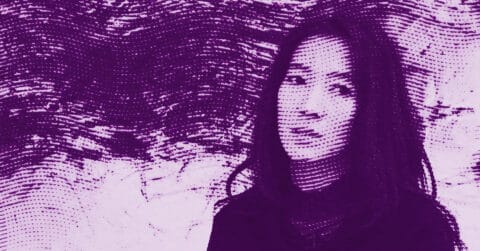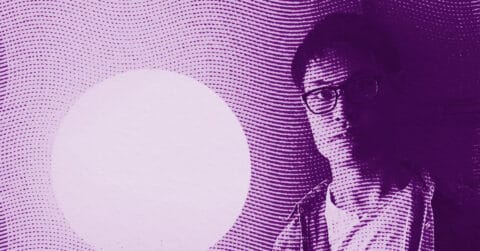Listen to me carefully, you bunch of snobs, you who parade around contemporary art fairs with your esoteric theories and intellectual poses. I am going to tell you about Dong Shaw-Hwei, born in 1962 in Taipei, an artist who categorically refuses to bow to the dictates of your small narcissistic and self-satisfied artistic world.
In a contemporary art landscape saturated with flashy installations and hollow conceptual works, Dong Shaw-Hwei emerges as a quiet but revolutionary force. She has built her artistic identity by merging Western Impressionism with Taoist philosophy, thus creating a body of work that transcends not only cultural boundaries but also the ephemeral fashions that so obsess today’s art market.
Her “Courtyard” series is not simply a collection of garden paintings. It is a visual manifesto against our era obsessed with speed and perpetual change. In these works, she captures the very essence of those traditional inner courtyards of Taipei that are disappearing under the relentless assaults of urban modernization. These spaces, with their century-old trees and mossy stones, become under her brush silent witnesses to a millennial wisdom that is fading. Each painting is a profound meditation on what Walter Benjamin called the aura, that unique appearance of a distant place, no matter how close it may be. These gardens are not mere nostalgic relics but spaces of active cultural resistance against the rampant homogenization of our urban environment.
The way Dong handles light in these works is particularly revealing. Unlike the Impressionists who sought to capture the fleeting moment, she creates a luminosity that seems to emanate from the objects themselves. It is as if she managed to materialize what Maurice Merleau-Ponty described in “The Eye and the Spirit” as “the second light” which does not come from outside but emanates from the thing itself. This unique approach transforms her paintings into true meditations on the nature of perception itself.
In her series “Still Life of Black Table”, she pushes her reflection on space and time even further. These still lifes transcend their traditional genre to become what Martin Heidegger would have called “unveilings of being”. The black table, recurrent in her compositions, is not a mere support for objects. It becomes a metaphysical theater where each object, each flower, each shadow carries within it a profound existential charge. The deep black of the table works as what Theodor Adorno named “the appearance of the non-apparent”, creating a reflective space where the viewer is invited to contemplate not only the represented objects but also their own relation to the material world.
The way she structures space in her compositions defies all established conventions. She follows neither the rules of Western perspective nor the conventions of traditional Chinese painting. Instead, she creates what Gaston Bachelard called a “poetics of space”, where spatial relations are dictated not by geometric rules, but by an internal logic that is more poetry than perspective. This approach is particularly evident in works like “The Golden Days in Courtyard” (2023), where space becomes a metaphor for consciousness itself.
Her use of color is equally revolutionary. Where the Impressionists sought to capture the vibration of natural light, Dong uses color as a philosophical tool. Her deep greens and velvety blacks are not there to imitate nature, but to create what Gilles Deleuze called “blocks of sensation”. Each shade is charged with a meditative intention that transforms the act of looking into an almost spiritual experience, without ever falling into the trap of easy mysticism.
What is particularly remarkable in her work is that she transforms the banal into the sublime without ever resorting to the spectacular artifices so common in contemporary art. In “The Old Courtyard-Happy Flowerbed I-II” (2021), she elevates a simple flowerbed to the rank of cosmic meditation. This ability to reveal the extraordinary in the ordinary recalls what Georges Perec described in “Infra-ordinary” as the necessity to question what seems so obvious that we have forgotten its origin.
Her treatment of botanical motifs in her recent works reveals a deep understanding of what Michel Foucault called “the order of things”. The plants in her paintings are not mere decorative elements, but living presences that participate in what the philosopher François Jullien names the “great shapeless image”. This approach is especially visible in works like “Plum blossoms in Courtyard I-II” (2023), where the flowers become full actors in a silent cosmic drama.
The way she approaches tradition is just as revolutionary. Instead of outright rejecting the pictorial heritage as so many contemporary artists do, or blindly submitting to it as traditionalists do, she engages in a critical dialogue with this heritage. Her deep understanding of Zhuangzi’s philosophy, on which she wrote a book in 1993, allows her to transcend the sterile dichotomy between tradition and innovation. Thus, she creates what Pierre Bourdieu would have called a unique “artistic habitus,” which is neither entirely Eastern nor completely Western.
In her recent compositions, especially in her series of diptychs, she pushes this fusion of traditions even further. The two-panel structure, inspired by traditional Chinese scrolls, becomes under her brush a sophisticated conceptual device that questions our perception of time and space. This approach recalls what Jacques Derrida called “différance,” that productive tension between presence and absence that generates meaning.
What makes her work particularly relevant today is that it resists the frenetic commercialization that characterizes the contemporary art world. Her works are not designed for Instagram selfies or spectacular auctions. They demand a form of attention that goes against our culture of constant distraction. In this sense, her art becomes what Guy Debord would have called an anti-spectacle, a form of silent but effective resistance against the society of the spectacle.
The feminist dimension of her work, although never explicitly claimed, is deeply rooted in her practice. As Simone de Beauvoir would have pointed out, the simple act of creating as a woman in an art world still largely dominated by men is in itself a political act. But Dong goes further. She manages to transcend gender stereotypes while creating art that fully embraces her feminine sensitivity.
Her treatment of still lifes is particularly revealing in this regard. Traditionally considered a minor “feminine” genre, she makes it a vehicle for profound philosophical reflections. In works like “A Peaceful Day-Pink Camellia” (2023), she transforms a simple floral arrangement into a meditation on the very nature of existence, recalling what Julia Kristeva calls “women’s time,” a cyclical temporality that opposes patriarchal linear time.
The way she handles abstraction in her recent works also deserves our attention. Unlike Western abstraction, which tends toward a total rupture with reality, her abstraction emerges organically from careful observation of the natural world. This approach recalls what François Jullien describes as the “great formless image” in Chinese thought, where the abstract is not the opposite of the concrete but its natural extension.
Her use of negative space in her compositions is particularly sophisticated. The voids in her paintings are not mere absences but active presences that structure the entire composition. This approach recalls what the Japanese philosopher Kitaro Nishida called the “place of nothingness,” a concept that transcends the Western opposition between being and non-being.
The way she approaches the question of memory in her works from the “Courtyard” series is deeply moving without ever falling into sentimentality. These gardens that disappear under the bulldozers of modernization become under her brush what Pierre Nora called “places of memory,” spaces where collective memory crystallizes and finds refuge. But unlike so many artists who merely document disappearance, Dong creates works that transform this loss into a source of beauty and reflection.
Dong Shaw-Hwei reminds us that true innovation does not consist in rejecting the past, but in creatively integrating it into a contemporary vision. Her work demonstrates that it is possible to create art deeply rooted in tradition while being radically contemporary. She proves to us that the real revolution in art does not lie in the spectacular rejection of established forms, but in their subtle and profound transformation. Her work is living proof that art can still be a space of resistance and reflection in a world dominated by spectacle and immediacy. She reminds us that true radicality in art does not lie in superficial provocation, but in the ability to create works that transform the way we see and think about the world.
So yes, you can continue to marvel at your flashy video installations and meaningless performances. But meanwhile, Dong Shaw-Hwei continues to create art that will still have meaning long after current fashions are forgotten. She reminds us that true art does not need to shout to be heard, that it can speak softly but deeply to the human soul. Her work remains a bastion of silent but powerful resistance.
















